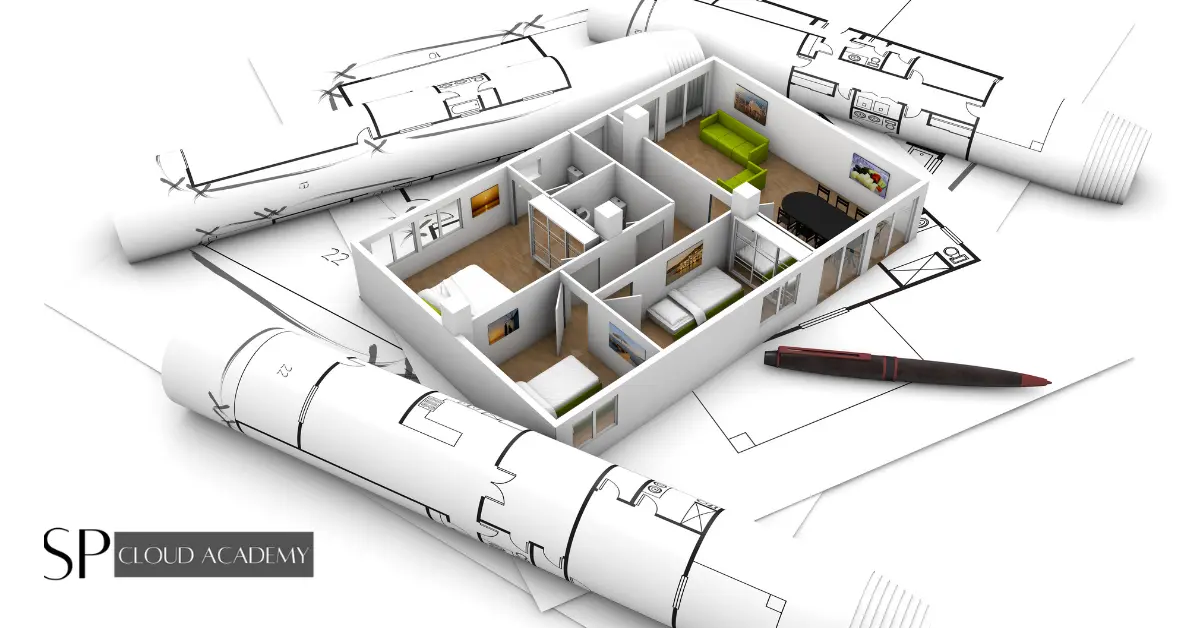Architectural and interior design software refers to computer programs and tools designed to aid professionals and enthusiasts in the creation, visualization, and documentation of architectural and interior design projects. These software applications offer a wide range of features, including 2D and 3D modeling, rendering, building information modeling (BIM), and collaboration capabilities.
Architects, interior designers, and related professionals use these tools to conceptualize, design, and communicate their ideas effectively. They can create detailed floor plans, 3D models, and realistic renderings, allowing clients and stakeholders to visualize the final results before construction begins.
Popular software options include AutoCAD, SketchUp, Revit, and 3ds Max, each tailored to specific design needs and preferences. These digital tools have revolutionized the design industry by streamlining workflows, improving accuracy, and enhancing creativity in architectural and interior design projects.
Architectural vs. interior design
Architectural design and interior design are two distinct yet closely related disciplines within the field of design and construction. They each have their own focus, scope, and responsibilities:
Architectural Design:
- Scope: Architectural design primarily deals with the design and planning of buildings and structures, considering their overall form, function, and integration into the surrounding environment.
- Scale: Architects work at a larger scale, designing entire buildings or complexes. Their focus extends beyond the interior spaces to the building’s external appearance, structural integrity, and its relationship to the surrounding landscape.
- Responsibilities: Architects are responsible for creating the architectural concept, designing the building’s layout and form, ensuring structural integrity, and often managing the construction process. They collaborate with various professionals, including engineers, to ensure that the building meets safety codes and regulations.
- Considerations: Architects take into account factors such as site conditions, climate, zoning laws, and sustainability when designing a structure. They often produce detailed blueprints and plans that guide the construction process.
Interior Design:
- Scope: Interior design focuses on the aesthetics, functionality, and interior spaces of buildings. It involves the arrangement and decoration of interior spaces to create functional and visually pleasing environments.
- Scale: Interior designers work at a smaller scale, concentrating on individual rooms or spaces within a building. Their primary concern is how people will use and experience these spaces.
- Responsibilities: Interior designers are responsible for selecting materials, furnishings, colors, lighting, and other elements to create a cohesive and attractive interior environment. They also consider the layout and flow of spaces within the building, ensuring that they meet the needs and preferences of the occupants.
- Considerations: Interior designers pay close attention to the human experience within a space, considering factors like ergonomics, comfort, and user preferences. They work to create functional and aesthetically pleasing interiors that align with the overall architectural design and the client’s vision.
In practice, architectural and interior designers often collaborate closely on projects to ensure that the interior spaces harmonize with the overall architectural concept. Successful projects typically require effective communication and coordination between these two disciplines to create cohesive and well-designed buildings that meet the needs of both the exterior structure and the interior spaces.
Importance
Architectural and interior design software plays a pivotal role in the industry by revolutionizing the design and construction processes. These software tools enable professionals to create intricate, accurate, and visually appealing designs, fostering innovation and efficiency. They facilitate collaboration among project stakeholders, from architects and interior designers to engineers and builders, streamlining communication and reducing errors. Moreover, they empower designers to experiment with ideas, iterate designs quickly, and visualize concepts in 2D and 3D, ultimately resulting in more informed decisions and better final outcomes. In an increasingly digital world, architectural and interior design software is essential for staying competitive, meeting client expectations, adhering to building codes and regulations, and ensuring the successful execution of projects from conception to completion.
Architectural and interior design essential features
When choosing architectural and interior design software, it’s important to consider various essential features that can greatly impact your ability to create, visualize, and document your designs effectively. Here are some of the key features to look for:
2D and 3D Modeling Tools:
- Explanation: 2D tools allow you to create floor plans and detailed drawings, while 3D modeling capabilities enable you to visualize your designs in three dimensions.
- Importance: These tools are fundamental for creating the initial design concept and transitioning it into a three-dimensional space.
Rendering and Visualization:
- Explanation: Rendering tools generate realistic images and visualizations of your designs, including lighting, materials, and textures.
- Importance: High-quality visualizations help you communicate your design ideas to clients, stakeholders, and team members effectively.
Building Information Modeling (BIM):
- Explanation: BIM software allows you to create intelligent 3D models that include data on building components, materials, and systems. It facilitates collaboration and helps in project management.
- Importance: BIM enhances accuracy, supports collaboration, and streamlines the design and construction process by providing a centralized database of project information.
Library of Objects and Materials:
- Explanation: A comprehensive library of pre-made objects, furniture, fixtures, and materials can save time and enhance the realism of your designs.
- Importance: Access to an extensive library simplifies the design process by providing a wide range of elements to choose from.
Ease of Use and Learning Curve:
- Explanation: User-friendly software with an intuitive interface and accessible learning resources can expedite the design process.
- Importance: A shorter learning curve allows designers to become proficient more quickly, improving overall efficiency.
Compatibility and File Formats:
- Explanation: The ability to import and export various file formats (e.g., DWG, DXF, FBX) ensures compatibility with other software and collaborators.
- Importance: Compatibility reduces potential issues when sharing files or collaborating with professionals who use different software.
Collaboration and Sharing Features:
- Explanation: Collaboration tools enable multiple team members to work on the same project simultaneously, while sharing options facilitate communication with clients and stakeholders.
- Importance: Collaboration features improve teamwork and streamline communication, making it easier to share progress and revisions.
Documentation and Drafting Tools:
- Explanation: Robust documentation tools help you create detailed drawings, blueprints, and construction documentation.
- Importance: Accurate documentation is essential for obtaining permits, complying with building codes, and ensuring a smooth construction phase.
Cost and Licensing Options:
- Explanation: Consider the software’s pricing structure, including whether it’s a one-time purchase, subscription-based, or free/open source.
- Importance: Your budget and long-term software requirements will determine which licensing option is most suitable for your needs.
Updates and Support:
- Explanation: Regular software updates and access to customer support can ensure that your software remains current and functional.
- Importance: Ongoing support and updates help you stay competitive and address any issues that may arise.
When evaluating architectural and interior design software, prioritize the features that align with your specific project requirements and workflow preferences. Conducting trial runs or demos of the software can be a valuable step in assessing how well it meets your needs.
Selecting the right software for various design needs
Selecting the right software for specific design needs is of paramount importance in the fields of architecture and interior design for several compelling reasons:
- Optimized Workflows: The right software aligns with the unique requirements of different projects, streamlining workflows and improving productivity. This ensures that designers can work efficiently and meet project deadlines.
- Precision and Accuracy: Different software tools offer varying levels of precision and accuracy. For complex architectural projects or designs requiring high levels of detail, the appropriate software helps maintain accuracy in measurements, layouts, and specifications.
- Visualization and Communication: Software tailored to the project’s needs allows designers to create realistic 2D and 3D visualizations. This enhances communication with clients, stakeholders, and team members, making it easier for them to understand and approve design concepts.
- Compliance and Documentation: Certain projects may require compliance with specific industry standards or building codes. The right software often comes with features that help in generating accurate and compliant documentation, reducing potential legal or regulatory issues.
- Collaboration: Collaboration is a fundamental aspect of design projects. The right software can facilitate collaboration by providing tools for easy sharing of files, project updates, and real-time communication among team members and stakeholders.
- Cost Efficiency: Investing in software that precisely matches project needs can be cost-effective. Overly complex software with features not needed for a particular project can lead to unnecessary expenses, while insufficient software might result in inefficiencies and costly errors.
- Learning Curve: Different software has varying learning curves. Selecting software that aligns with a designer’s skill level and expertise ensures a smoother adoption process and faster proficiency.
- Flexibility and Adaptability: Design needs can evolve throughout a project. Choosing software that can adapt to changing requirements or scale to accommodate larger or more complex projects is crucial for long-term success.
- Client Satisfaction: Ultimately, the right software helps designers deliver high-quality, visually appealing designs that meet or exceed client expectations. This can lead to satisfied clients who are more likely to recommend the designer or firm for future projects.
- Competitive Advantage: In a competitive industry, having the right software can provide a competitive edge. Designers who can produce impressive, accurate, and compliant work efficiently are more likely to win contracts and gain a reputation for excellence.
In summary, selecting the appropriate software for specific design needs is not only essential for project success but also for improving efficiency, client satisfaction, and the overall competitiveness of design professionals and firms in the architectural and interior design industry.
Best architectural and interior design software
The choice of the best architectural and interior design software can depend on your specific needs and preferences. Different software tools offer various features and capabilities, so it’s important to consider your project requirements and skill level. Here are some of the top architectural and interior design software options as of my last knowledge update in September 2021:
- AutoCAD: AutoCAD is one of the most widely used CAD (Computer-Aided Design) software for architects and designers. It’s known for its precision and 2D/3D drafting capabilities.
- SketchUp: SketchUp is known for its ease of use and is popular among architects, interior designers, and 3D modelers. It’s great for creating 3D models and visualizations.
- Revit: Developed by Autodesk, Revit is a BIM (Building Information Modeling) software that’s highly regarded for its ability to create detailed 3D models with data-rich information. It’s excellent for architectural design and construction documentation.
- 3ds Max: Also from Autodesk, 3ds Max is a powerful 3D modeling and rendering software widely used for architectural visualization and interior design.
- Rhino: Rhino is a versatile 3D modeling software that is popular among architects and designers for its flexibility and the ability to create complex 3D shapes.
- Blender: While Blender is primarily known as a 3D modeling and animation tool, it’s a free and open-source software that can be used for architectural and interior design projects as well.
- Chief Architect: Chief Architect is specialized software for residential and light commercial design. It’s known for its ease of use and 3D visualization features.
- ArchiCAD: ArchiCAD is a BIM software similar to Revit and is popular among architects for its ability to create detailed 3D models and construction documentation.
- Sweet Home 3D: Sweet Home 3D is free and open-source interior design software that’s user-friendly and great for creating 2D floor plans and 3D interior visualizations.
- Lumion: Lumion is a real-time 3D visualization tool that can turn 3D models into stunning visualizations and animations, making it a valuable addition to the design process.
- Cinema 4D: Cinema 4D is a 3D modeling, animation, and rendering software used for architectural visualization and creating high-quality 3D graphics.
- Vectorworks: Vectorworks is a versatile design and BIM software used by architects, interior designers, and landscape architects.
When selecting the best software for your needs, consider factors like your level of expertise, the complexity of your projects, collaboration requirements, and budget constraints. Many of these software options offer free trials, so it’s a good idea to try them out before making a final decision.
Trends and Future Developments
The field of architectural and interior design software continually evolves to meet the changing needs of professionals and to take advantage of advancements in technology. As of my last knowledge update in September 2021, here are some trends and potential future developments in this domain:
- Cloud-Based Solutions: The adoption of cloud-based design software is on the rise. These platforms allow for real-time collaboration and access to design data from anywhere, enhancing teamwork and flexibility.
- AI and Generative Design: Artificial intelligence (AI) is being integrated into design software to assist in tasks like generating design options, automating repetitive tasks, and analyzing data to optimize building performance.
- Virtual Reality (VR) and Augmented Reality (AR): VR and AR technologies are increasingly used for immersive design experiences. Designers can use VR to walk through their creations, while AR can overlay digital designs onto the physical world, aiding in visualization.
- Sustainability and Green Design: Sustainability is a growing concern, and design software is incorporating tools to assess the environmental impact of designs, calculate energy efficiency, and make more sustainable material choices.
- Parametric Design: Parametric design tools enable designers to create complex, adaptive structures and forms. This trend is particularly prevalent in architecture and allows for efficient exploration of design variations.
- Mobile and Tablet Applications: Mobile apps for design and sketching are becoming more powerful, allowing designers to work on the go and capture inspiration as it strikes.
- Virtual Collaboration and Remote Work: Given the rise in remote work, design software is increasingly emphasizing features that facilitate virtual collaboration among dispersed teams.
- Blockchain for Design Data Management: Blockchain technology has the potential to enhance security and traceability in design data management, ensuring the integrity and ownership of design files.
- Customization and Personalization: Design software is moving towards greater customization to cater to individual user needs. This includes customizable interfaces, tools, and workflows.
- OpenBIM Standards: OpenBIM standards promote interoperability among different design and construction software. This trend is essential for seamless data exchange and collaboration.
- Predictive Analytics: By leveraging data and analytics, design software can provide insights into project outcomes, helping designers make more informed decisions.
- Ethical and Inclusive Design: The industry is focusing on ethical considerations, including accessibility and inclusivity, and design software is incorporating features to assess designs for these criteria.
- Human-Centered Design: Design software is becoming more user-centric, with intuitive interfaces and features that prioritize the human experience in design.
It’s important to note that these trends are subject to rapid change, and new developments may have emerged since my last knowledge update. Design professionals should stay informed about the latest advancements in architectural and interior design software to remain competitive and make the most of the available tools and technologies.
Learning Resources and Training
Learning resources and training are essential for becoming proficient in architectural and interior design software. Here are some valuable resources and training options to consider:
Official Software Documentation:
- Most software providers offer comprehensive user manuals and documentation on their websites. These resources provide in-depth information about software features and functionalities.
Online Tutorials and Courses:
- Websites like Udemy, Coursera, LinkedIn Learning, and Skillshare offer a wide range of online courses on architectural and interior design software. Look for courses specific to the software you’re using.
- YouTube is also a valuable source for free video tutorials. Many experts and software users create instructional videos covering various aspects of design software.
Software Training Centers:
- Many cities have training centers that offer in-person or virtual courses specifically tailored to design software. These centers often provide hands-on training and certification programs.
Webinars and Workshops:
- Software providers frequently host webinars and workshops to showcase advanced features, tips, and best practices. These events are usually free and allow for interaction with experts.
User Forums and Communities:
- Online user forums and communities, such as Autodesk’s forums or SketchUp’s community, are great places to ask questions, share experiences, and learn from other users.
Books and eBooks:
- Some software books are available for purchase or download in eBook format. Look for titles that focus on specific software or design principles.
Professional Associations:
- Joining professional associations related to architecture or interior design often provides access to educational resources, networking opportunities, and events that include software training.
Local Design Schools and Colleges:
- Many educational institutions offer courses and workshops on design software. While these may be more formal and structured, they can provide comprehensive training.
Online Forums and Groups:
- Participate in online forums and social media groups dedicated to design software. These communities are excellent for asking questions, sharing experiences, and learning from peers.
Software Certification Programs:
- Some software providers offer certification programs to validate your proficiency in their products. Earning a certification can enhance your credibility and job prospects.
Customized Training and Consulting:
- For more tailored training, consider hiring a consultant or expert in your chosen software to provide one-on-one or team training sessions.
Trial and Error:
- Don’t underestimate the power of experimentation. Open the software, explore its features, and practice creating designs. Learning by doing can be highly effective.
Remember that continuous learning is crucial in the ever-evolving field of design software. Stay updated with the latest software updates, features, and industry trends by regularly engaging with learning resources and training opportunities.
Conluusion
In conclusion, architectural and interior design software is an indispensable tool for professionals and enthusiasts in the design and construction industries. Selecting the right software tailored to your project needs and workflow is paramount to success. Key features to consider include 2D and 3D modeling, rendering, BIM capabilities, a library of objects and materials, ease of use, compatibility, collaboration tools, documentation support, cost, and ongoing support and updates.
As the industry continues to evolve, trends and future developments include the adoption of cloud-based solutions, AI and generative design, VR and AR integration, sustainability focus, and parametric design, among others. Staying updated on these trends and utilizing relevant learning resources and training options is essential for design professionals.
In the dynamic world of architectural and interior design, mastering software tools not only enhances efficiency but also empowers designers to create innovative, sustainable, and aesthetically pleasing spaces. Whether you are an architect, interior designer, or student, embracing the right software and investing in your ongoing education can lead to a successful and fulfilling career in the design industry.



